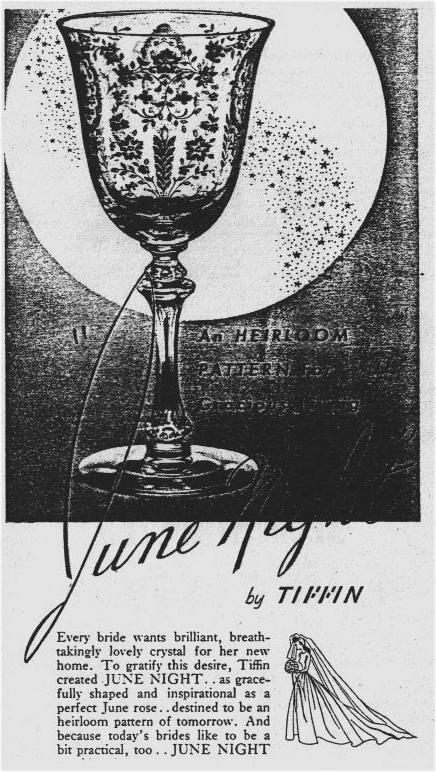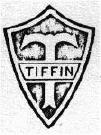National Depression Glass Association
Preserving America's Glass Manufacturing Heritage
Tiffin's "June Night" Pattern
by Virginia Scott
Rainbow Review Glass Journal - January 1975
The United States Glass Company of Tiffin, Ohio, named "June Night" their most popular pattern for Elizabeth Gordon's survey, "The 15 Most Popular Patterns" (House Beautiful, Dec. 1942).
 The
advertisement shown here appeared in a 1943 magazine, and is the only
one that I have found for the pattern. The ad states that "June Night"
is an "exquisitely etched pattern". The motif, described by Ms. Gordon
as "romantic traceries of roses", is a delicate, decorative arrangement
of flowers and foliage which alternates with a medallion. The pattern
was made in a complete table service which, as the ad specifies, was
"open stock so that you can replace and add to your collection at any
time." The survey illustration shows a goblet, plate and a sugar howl
with curved, beaded handles. The bowl of the stemware is a graceful
bell-shape and the stem is a classic fluted column. The ad stresses
that "June Night" is an "Heirloom Pattern" but that it has "enduring
qualities that make it perfect for every day." It is also disclosed
that it is "moderately priced ... at your favorite store ... usually
$1.25 to $1.50". I would speculate, from the date, the pattern was made
in clear crystal only.
The
advertisement shown here appeared in a 1943 magazine, and is the only
one that I have found for the pattern. The ad states that "June Night"
is an "exquisitely etched pattern". The motif, described by Ms. Gordon
as "romantic traceries of roses", is a delicate, decorative arrangement
of flowers and foliage which alternates with a medallion. The pattern
was made in a complete table service which, as the ad specifies, was
"open stock so that you can replace and add to your collection at any
time." The survey illustration shows a goblet, plate and a sugar howl
with curved, beaded handles. The bowl of the stemware is a graceful
bell-shape and the stem is a classic fluted column. The ad stresses
that "June Night" is an "Heirloom Pattern" but that it has "enduring
qualities that make it perfect for every day." It is also disclosed
that it is "moderately priced ... at your favorite store ... usually
$1.25 to $1.50". I would speculate, from the date, the pattern was made
in clear crystal only.
The history of the United States Glass Company is complex. In 1891,
eighteen glass factories from Pennsylvania, Ohio and West Virginia
merged to become the United States Glass Company. A. J. Beatty, &
Sons of Tiffin, Ohio, became Factory "R" in the organization. Quality
glassware was produced by the hand-method at the "R" plant. During the
1920s, this glassware became known as TIFFINware. Beautiful lines of
blown stemware and pressed dinnerware were produced, some elegantly
plain while others were skillfully etched or cut. Much color was used,
including blue, green, pink, amber, canary, lilac and black. Solid

 colors often had "contrasting trim" and crystal had "color trim". Much
of the stemware combined crystal bowls with colored stems. Some pieces
were marked with the intertwined letters "U S G Co" (at right) while others had a
gold "Tiffin Crest" trademark label (at left).
colors often had "contrasting trim" and crystal had "color trim". Much
of the stemware combined crystal bowls with colored stems. Some pieces
were marked with the intertwined letters "U S G Co" (at right) while others had a
gold "Tiffin Crest" trademark label (at left).
Many of the plants of United States Glass Company withdrew or failed, but the Tiffin plant has managed to survive through crisis and changes of ownership. Tiffin is now owned by a large conglomerate, the Interpace Corporation. This corporation also owns Franciscan China. Some of the ads of the l970s feature coordinated glassware and china, using the Franciscan name.